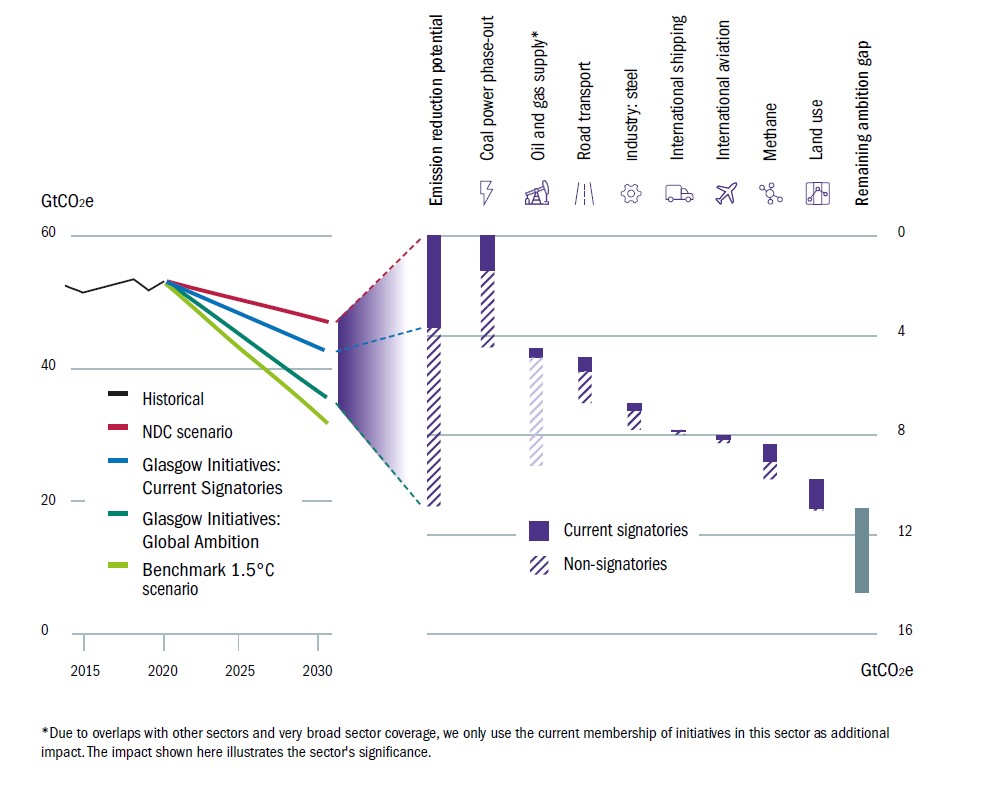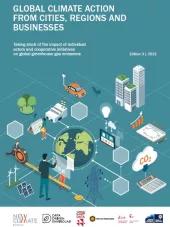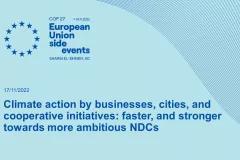We identified 601 ICIs launched since 2013 with more than 70,000 instances of participation by cities and regions, businesses, and by domestic and international NGOs. The total number of ICIs covered in this study has more than doubled compared to previous analyses as a result of examining outcomes from all major climate summits and campaigns since 2014. The growth of active initiatives (85% of all ICIs launched since 2013) has flattened since 2019. This is partly explained by the expiration of many initiatives that were launched prior or around the UN Climate Conference in Paris in 2015. The outbreak of the COVID 19 pandemic may also explain lower growth of new initiatives, especially in 2020.
The global status of mitigation-related initiatives is bleaker than in the past assessments. In sum, performance trends in recent years give some reasons for concern.
Overall productivity of initiatives is trending downwards. Since 2019, we observe higher shares of badly or non-performing initiatives both in mitigation and adaptation. These initiatives do not produce tangible outputs relevant to their goals. Overall performance of initiatives is also trending downwards. ICIs have been launched without further implementation and operationalization of commitments. This gap between commitments and implementation risks to undermine the credibility of ICIs and the campaigns and summits that convene them. The downwards trend in productivity may be explained by ICIs initially picking ‘low-hanging fruit’ and subsequently having to take more difficult measures. Moreover, the COVID-19 pandemic has likely affected the performance of ICIs.
Our analysis suggests a strong and growing underrepresentation of the Global South. Although ICIs have great potential to contribute to sustainable development in developing countries, studies have consistently shown a strong underrepresentation of the Global South. Implementation disproportionately takes place in the Global North. In line with previous assessments our analysis shows the underrepresentation of funders, leaders, and participants of ICIs based in non-OECD countries. Moreover, since 2015 the share of outputs produced in the Global North has steadily grown. Some imbalances are to be expected as they appropriately and reflect differentiated responsibilities and the need for a strong focus on climate mitigation. Nonetheless, the benefits of ICIs, particularly adaptation and resilience building, should also accrue to developing countries.
The initiatives launched at COP26 (“Glasgow Initiatives”) have the potential to fill a considerable part of the ambition gap in 2030 between current NDCs and 1.5°C-consistent emission pathways, but this potential will only materialise if more countries, especially large emitting countries, join them and fully deliver.
The report assessed the potential contributions of 12 international sector initiatives launched around and during COP26 (hereinafter, ‘Glasgow initiatives’) on future greenhouse gas (GHG) emission reductions. We found that the theoretical coverage of these Glasgow initiatives is large, they cover sectors that could potentially fill approximately 75% of the 14 GtCO2e ‘ambition gap’ in 2030 between the reference NDC scenario and the benchmark 1.5°C scenario (Figure 1). But not all governments have signed up and impact of signatories is quite small because many already have the action included in their NDC: Therefore, a full implementation of the initiatives’ 1.5°C-aligned goals by the current signatories would only lead to about 4 GtCO2e of emission reductions additional to the NDC scenario (Figure 1).
Ambition can be raised in two ways based on these results: First, the biggest potential lies in additional governments signing up to initiatives that have not yet done so (7 GtCO2e). The theory of change of the initiatives is to put non-signatories on the spot, but membership since the Glasgow COP has changed only marginally. Second, governments that have signed up have not yet fully taken these actions into account in their NDCs and therefore could increase the ambition in their NDCs (4GtCO2e).

Figure 1: (Left) Potential GHG emissions reductions resulting from full implementation of selected Glasgow initiatives. The emission projections for the reference NDC scenario and the benchmark 1.5°C scenario are also presented. (Right) Coverage of the ‘ambition gap’ between the reference NDC and the benchmark 1.5°C scenarios by the Glasgow initiatives.
Future COPs could generate momentum in sectors not covered by the Glasgow initiatives. Although the Glasgow initiatives’ emission reduction potential is substantial, there are still sectors in which momentum for rapid transition toward decarbonisation is needed, including the buildings sector and heavy industry sectors other than steel, such as chemicals and cement. These sectors have not been well covered by ICIs, especially by those that involve large emitting countries and established international institutions. The presidencies of the next few COPs as well as the UN Climate Change High-Level Champions may take the leadership to generate momentum to accelerate decarbonisation in these sectors.






